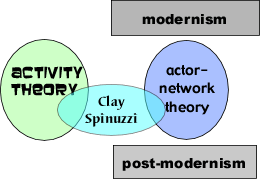
Activity theorists and actor-network theorists have been sniping at each other. They been saying "no" to each other's position. In his book: Network- Theorizing Knowledge Work, Clay Spinuzzi placed himself in their crossfire and said "yes" to both positions. He found common ground between the two positions as well as valuable ways they differ. Rather than invalidate their differences, he found uses for them like a practicing pragmatist. Rather than indulge in a reductionism of their positions to simplify their attacks on each other, he allowed for each to be complex and multifaceted. Blessed are the peacemakers.
Actor-network theorists have been caught in a different crossfire between modernism and post-modernism. While those two positions have been saying "no" to each other, Bruno Latour has gotten in the middle and said "no" to both. Rather than identifying common ground, he has defined a third position that refutes both of the others as lacking realism. Both added layers of conceptual baggage which obscure the flat reality of subtle tracings, changing alliances, reversible agreements and symmetric interactions. Latour restores innocence, wonder and fascination with each immediate occasion. Blessed are the meek.
As I've entertained both of these strategies in my mind, I've been to see a pattern to the variety "interstitial arguments". Here's the possible framework for considering our options when caught in the crossfire of opposing positions:
- It's possible the positions remain opposed because they occur in a causal or developmental sequence. One leads to the other, provides preliminary "sedimentation" or lays the groundwork for the other to follow. Then it can be argued the two are different phases, stages or developments of a shared process. Acorns and oak trees cannot be the same size, enact the same growth patterns or relate to other trees in the same ways.
- It's possible the positions remain opposed because they need each other as rivals, enemies or missing halves. Together they form vicious which go round endlessly. They perpetuate dramas of reacting to each other's prior reactions in order to compensate for each other's shortcomings. Then it can be argued there is no end in sight until the need for each other enters into the squabbling and exposes the perpetual uses made of the disagreements.
- It's possible the positions remain opposed because they need to be redeemed by an outsider position. Both lack the perspective to recognize interaction patterns, possible exit strategies or reversals of single-minded pursuits. Then it can be argued that it takes both to achieve the overall effect as if they are two sides of one coin or two ingredients in one concoction.
- It's possible the positions remain opposed because it's time for a transformation. Both positions are constituents of the emergent disintegration which is getting replaced or facing it's imminent extinction. Then it can be argued the two have taught us how to experience the "worst of both" alternatives while we're learning how to realize the "best of both" paradoxically.
A framework like this changes how we problematize getting caught in the crossfire. Our actions are mediated by these possibilities to become more pragmatic and strategic. Our effects on the opposing positions will be improved. We will have argued effectively for different definitions of positions, players and interactions.
No comments:
Post a Comment